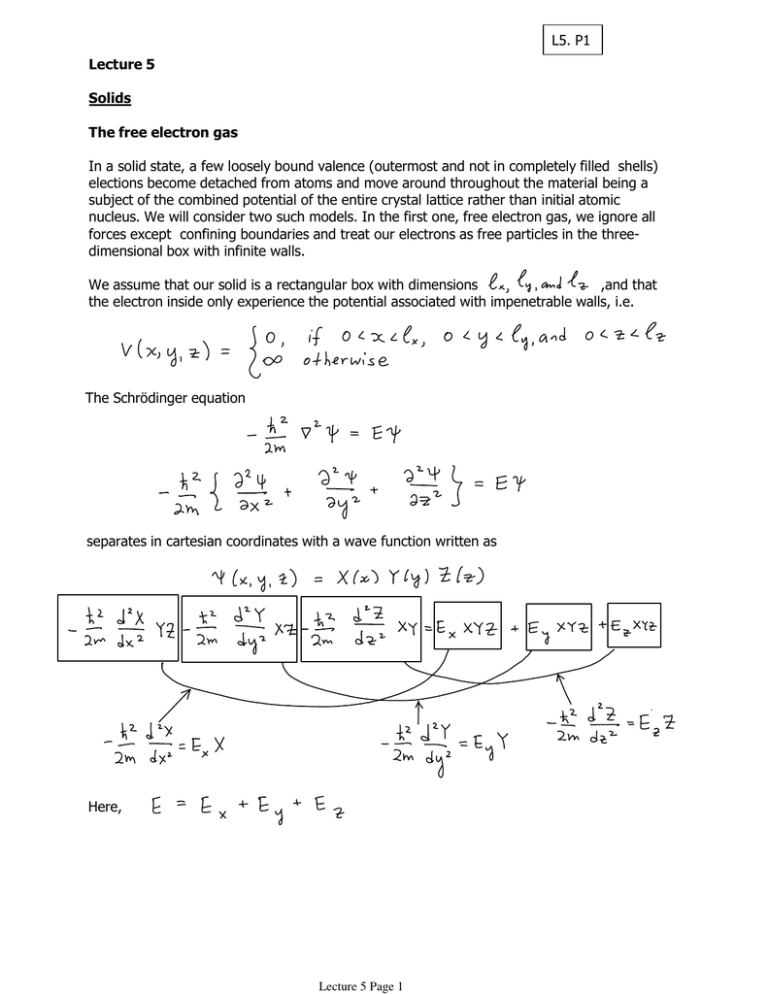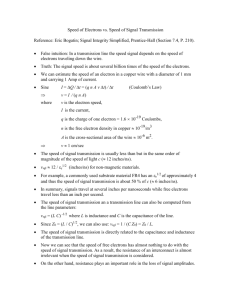Free electron gas
advertisement

L5. P1 Lecture 5 Solids The free electron gas In a solid state, a few loosely bound valence (outermost and not in completely filled shells) elections become detached from atoms and move around throughout the material being a subject of the combined potential of the entire crystal lattice rather than initial atomic nucleus. We will consider two such models. In the first one, free electron gas, we ignore all forces except confining boundaries and treat our electrons as free particles in the threedimensional box with infinite walls. We assume that our solid is a rectangular box with dimensions ,and that the electron inside only experience the potential associated with impenetrable walls, i.e. The Schrödinger equation separates in cartesian coordinates with a wave function written as Here, Lecture 5 Page 1 L5. P2 Making the following substitutions: we get The solutions of the above equations are cos and sin: Now, we use our boundary conditions. At the infinite walls, our wave function is zero. From Eq. (1), we get that since From Eq. (2), we get the following Note: has to be positive from its definition. Lecture 5 Page 2 L5. P3 Similarly, The normalized wave functions are and the allowed energies are 3D k-space with axes Imagine a grid with each block in this grid being produced with lines drawn at Each intersection point in this block represents a distinct one-particle state. Each block in this grid, and; therefore, each state occupies a volume of k-space. Lecture 5 Page 3 L5. P4 Suppose our solid contains N atoms with each atom contributing q free electrons and our solid is in its collective ground state (no thermal excitations). If the electrons were distinguishable particles or bosons they all would have been in the ground state, However, electrons are identical fermions and obey Pauli exclusion principal, so only two of them can occupy any particular state (two because of the spin, one being "spin up" and another one being "spin down" We can say that electrons will fill up one octant (i.e. 1/8 part, see picture) of a sphere in k-space. The radius of that sphere is determined by the volume required for each pair of electrons ( ): We assume that we have N atoms with each atom contributing q free electrons. Each pair needs volume , we so need to divide Nq by 2. We define the free electron density . The boundary that separates occupied and unoccupied states in k-space is called the Fermi surface. The corresponding Fermi energy, i.e. the energy of the highest occupied state, is Lecture 5 Page 4 L5. P5 How do we find the total energy of a free-electron gas? A shell of thickness dk contains a volume The number of electron states in this shell is Two electrons occupy volume. Each of these states has energy Therefore, the energy of the dk shell in the picture above is Therefore, the total energy is an integral over the k-space up to Fermi surface: This quantum mechanics energy is similar to the internal thermal energy U on the ordinary gas. It exerts a pressure on the walls since if the box expands by dV, the total energy will decrease: This shows up as work done on the outside by the quantum pressure P. Lecture 5 Page 5 L5. P6 This pressure is sometimes called degeneracy pressure. Exercise # 1 The density of copper is 8.96 gm/cm3, and its atomic weight is 63.5 gm/mole. (a) Calculate the Fermi energy for copper. Assume q=1 and give your answer in electron volts. (Remember: is number of free electrons per unit volume). Note: Avogadro's number is the number of atoms in exactly 12 grams of 12C. A mole is defined as this number of "entities" (usually atoms or molecules) of any material. Note : to remember Lecture 5 Page 6 L5. P7 (b) What is the corresponding electron velocity? Is it safe to assume that the electrons in copper are non-relativistic? (c) At what temperature would the characteristic thermal energy (kBT, where kB is Boltzman constant and T is Kelvin temperature) equal the Fermi energy for copper? Comment: This is called Fermi temperature. As long as the actual temperature is substantially below the Fermi temperature, the material can be regarded as cold. Since the melting point of copper is 1356 K, solid copper is always cold. (d) Calculate degeneracy pressure of copper, in the electron gas model. Hint: units are supposed to be N/m2. Lecture 5 Page 7


